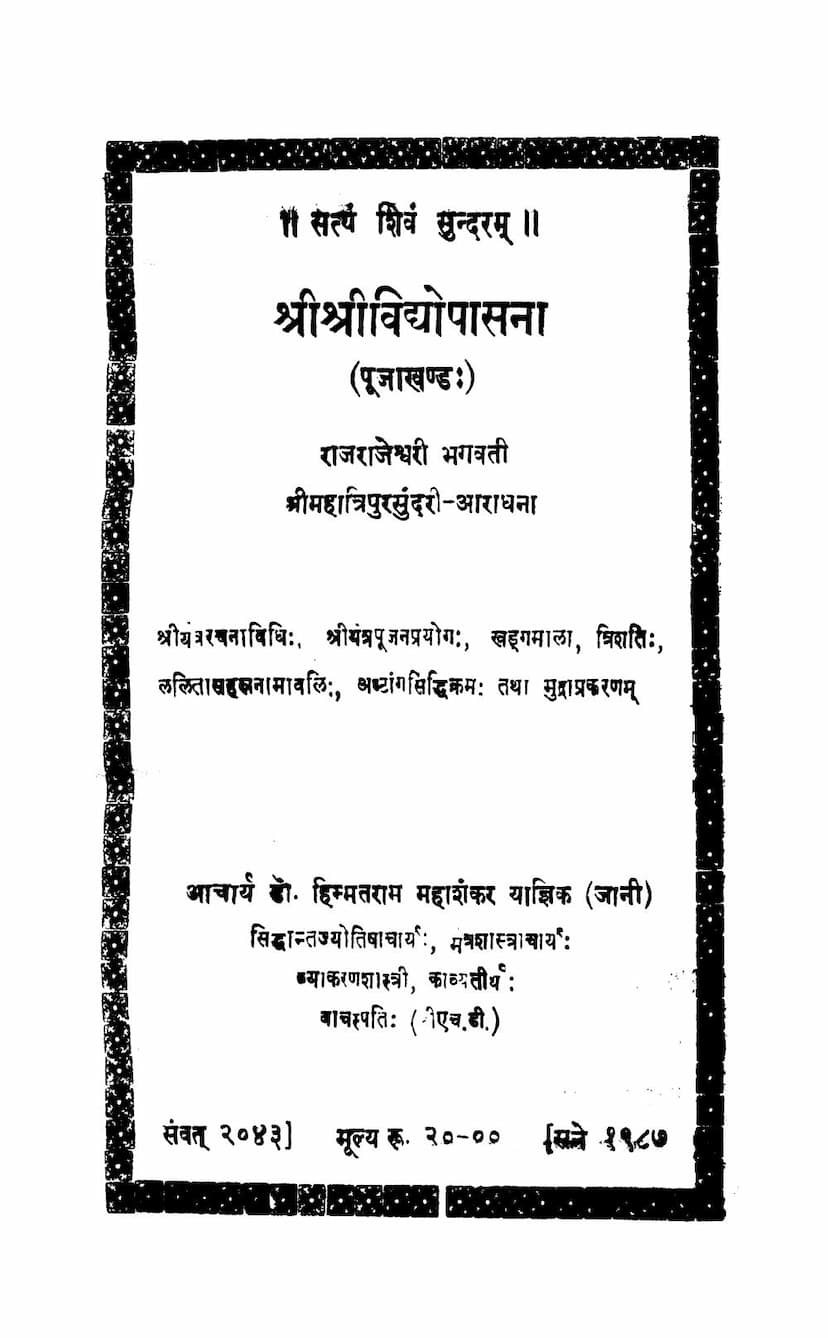Vidyopasna
Added to library: September 2, 2025

Summary
Here's a comprehensive summary of the Jain text "Vidyopasana" by Himmatram Mahashankar Yagnik, based on the provided pages:
Title: Vidyopasana (specifically the Puja Khand, focusing on the worship of Bhagavati Bheema Tripurasundari) Author: Acharya H. Himmatram Mahashankar Yagnik (Jani), a scholar in various fields including Jyotisha, Shastra, Vyakarana, and Kavya. Publisher: Yogesh Yagnik Year of Publication: Samvat 2043 (1987 CE)
Overall Purpose and Scope:
"Vidyopasana" is a comprehensive guide to the worship of the Divine Mother, Goddess Maha Tripurasundari, within the framework of Shri Vidya, a significant tradition in Tantric Hinduism and Jainism. The text focuses on the ritualistic aspects of worship, providing detailed instructions and explanations for practitioners. It aims to equip the worshipper with the necessary knowledge and procedures to perform the upasana effectively, leading to spiritual growth and fulfillment.
Key Components and Contents:
The book is structured to cover various aspects of the worship, from preliminary preparations to advanced rituals and philosophical underpinnings. Based on the table of contents and the initial pages, the following are the main themes and sections:
-
Introduction (Prastavana): The author shares his personal journey of devotion, influenced from childhood. He mentions his earlier works like translations of devotional hymns and the "Shivananda Lahari" and "Sowbhagya Lahari." He explains that this book fulfills a perceived gap after the previous editions of his "Sowbhagya Lahari" which lacked a detailed puja methodology. He expresses joy in completing this aspect of worship. The author also expresses gratitude to the family of Seth Shri Chimanlal Popatlal (Ranasaheb) for their encouragement and to his daughter, Bharati, and a disciple/friend, Natwarlal Yagnik, for their contributions. He also acknowledges the input of Mr. Shantilal M. Shastri for the "Balatripura Vidhana."
-
Devotion to Deities: The initial pages indicate a strong inclination towards the worship of various deities, particularly Bhagavati Bheema Tripurasundari. The text is dedicated to the memory of the late Seth Shri Chimanlal P. (Rasak), highlighting his interest in mantra and tantra shastras and his deep devotion to Maha Tripurasundari.
-
Shri Yantra: A significant portion of the book is dedicated to the Shri Yantra, a sacred geometric diagram central to the worship of Tripurasundari.
- Shri Yantra (Vichitra): Likely an illustration of the Shri Yantra.
- Shri Yantra Rachnakar (Construction): Detailed step-by-step instructions on how to draw or construct the Shri Yantra are provided, including geometric measurements, marking points, and drawing lines. This section is highly technical and guides the practitioner through a precise process.
- Pratah Smaranadi Guru Stotrani: Morning invocation prayers to gurus are included, emphasizing the importance of lineage and spiritual guidance.
- Shri Yantra Puja Prayog: This is a core section detailing the practical application of worshipping the Shri Yantra. It includes:
- Pratah Krityam (Morning Rituals): Daily routines performed in the Brahmamuhurta (auspicious pre-dawn period).
- Guru Upasana: Worship of the guru and paramaguru, including specific mantras and the "Gurupaduka Panchakam" (five verses on guru's sandals).
- Mudra Prakaranam (Chapter on Mudras): Explanation and description of various hand gestures (mudras) used in the ritual.
- Bhuta Shuddhi (Purification of Elements): A yogic process to purify the body's constituent elements.
- Prana Pratishtha (Installation of Life Force): Rituals to instill life force into the yantra or image.
- Nyasa Vidhi (Placement Rituals): Detailed instructions on the placement of specific mantras or divine energies on different parts of the body (Karanyas, Shadanga Nyas, Matrika Nyas, etc.). This is crucial for invoking the deity within oneself.
- Mantra Snanam (Mantra Bath): Ritualistic bathing using mantras.
- Mantra Sandhya (Mantra Twilight Rituals): Tantric sandhya rituals.
- Panchopachara/Shodashopachara/Chatuhshastyupachara Puja (Worship with Five/Sixteen/Sixty-four Offerings): Detailed procedures for offering various items to the deity.
- Avarana Puja (Worship of Enclosures/Surrounding Deities): The Shri Yantra has concentric enclosures, each representing different divine energies or deities. This section details the worship of each enclosure, from the Bindu Chakra to the outer enclosure.
- Archana of Devi: The main worship of the Goddess herself.
-
Specific Hymns and Mantras:
- Lalita Panchakam: Five verses invoking Lalita by Adi Shankaracharya.
- Khadgamala Mantra: A powerful mantra associated with the "sword garland."
- Sri Sowbhagya Ashtottara Shatanamavali (108 Names): A litany of auspicious names of the Goddess.
- Trishati Stotram: A hymn of 300 names.
- Lalita Sahasranamam: The popular hymn of 1000 names of Lalita.
- Ashtanga Siddhikram: A section on the eight-limbed siddhis (accomplishments), potentially related to the calculations for determining auspicious times or astrological elements for rituals. This section appears to be a manual for astrological calculations used in conjunction with the rituals.
- Mudra Prakaranam: A detailed section on various mudras used in the puja.
-
Practices for Specific Worshippers:
- Bala Vidhanam: Worship of Bala Tripurasundari, a child form of the Goddess.
- Special Instructions for Shodashopasaka: Specific guidance for worshippers of the Shodashi (16-syllabled mantra) form of the Goddess, possibly highlighting differences in practice or requirements.
-
Mental Worship (Devi Manasa Puja): A section describing how to perform the worship mentally, which is crucial for those who cannot perform elaborate physical rituals.
-
Concluding Remarks: The book seems to conclude with peace chants (Shanti Stotra) and offerings of thanks.
Underlying Philosophy:
The text emphasizes the interconnectedness of the microcosm (the worshipper's body) and the macrocosm (the universe). Through elaborate nyasas and visualizations, the worshipper aims to internalize the divine presence, making their own body a sacred space for the Goddess. The importance of a guru, proper initiation, and adherence to traditional practices is evident throughout the text.
In essence, "Vidyopasana" is a detailed and scholarly manual for the intricate and profound worship of Maha Tripurasundari, providing the necessary rituals, mantras, yantras, and philosophical context for dedicated practitioners.